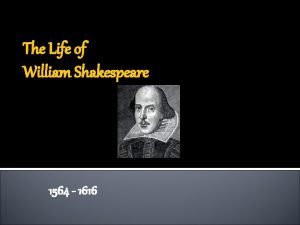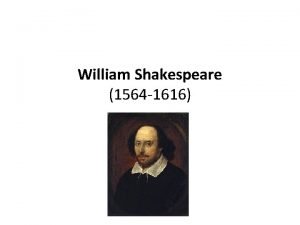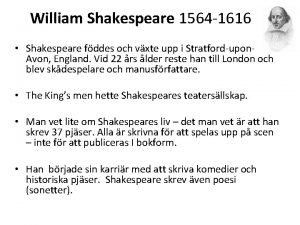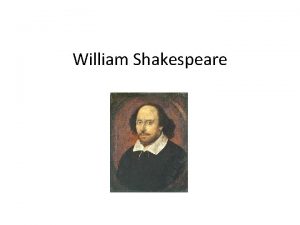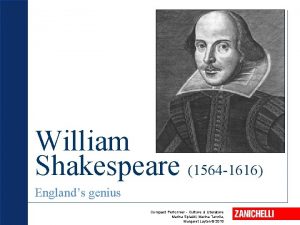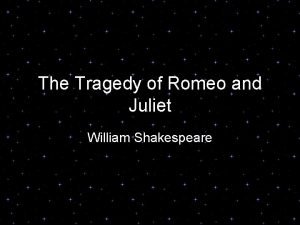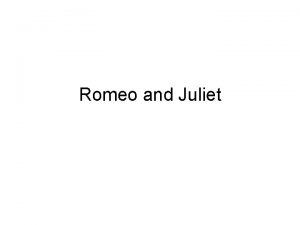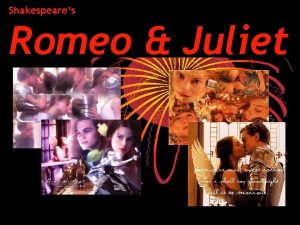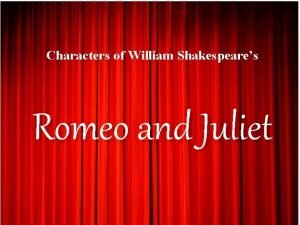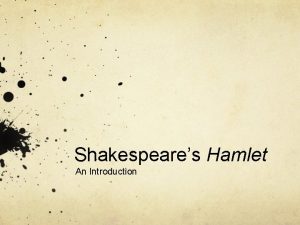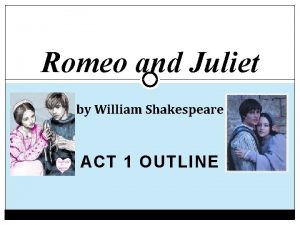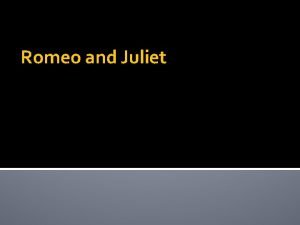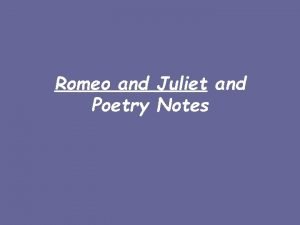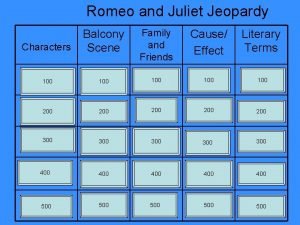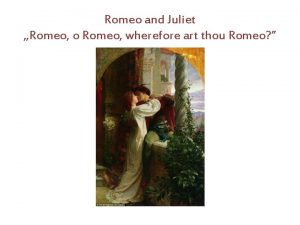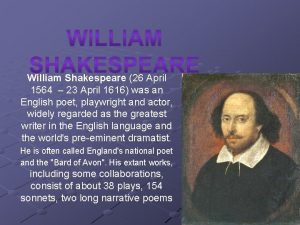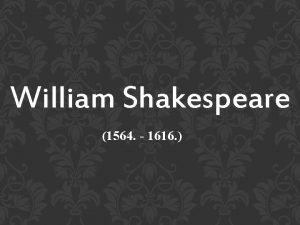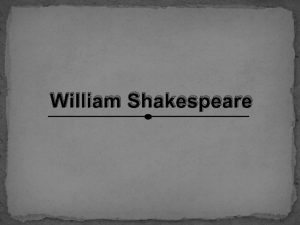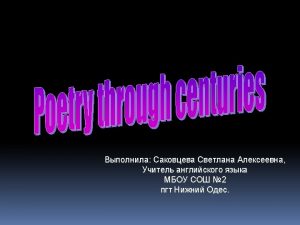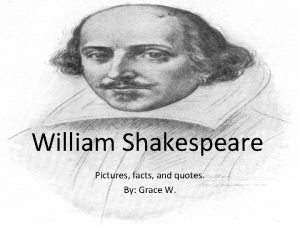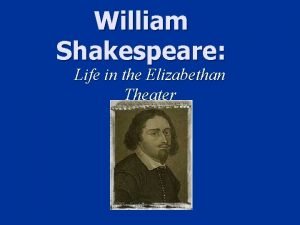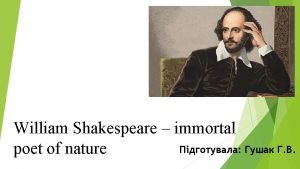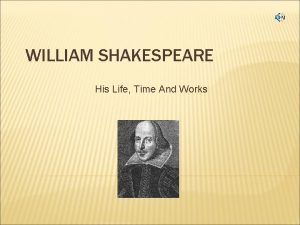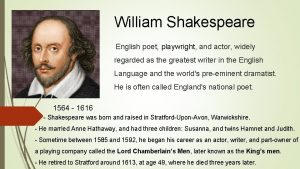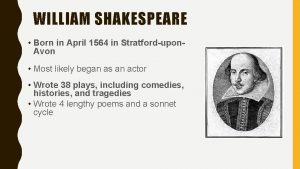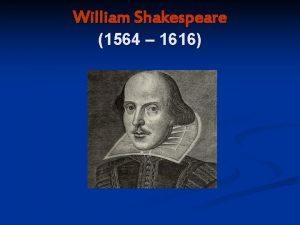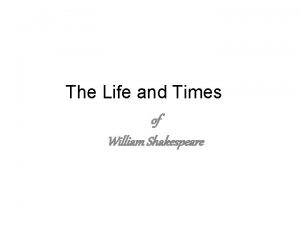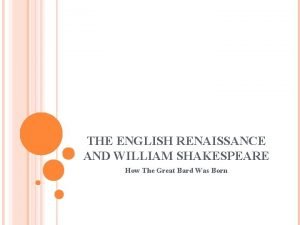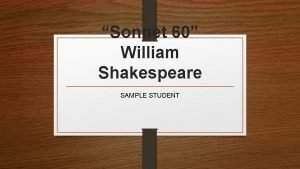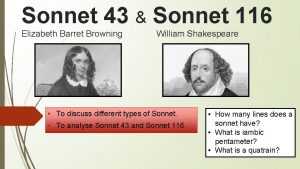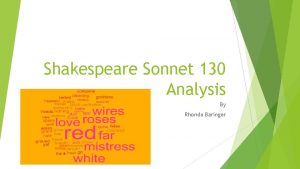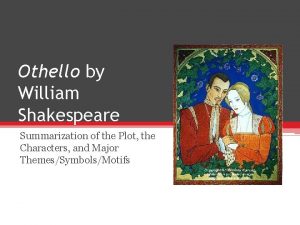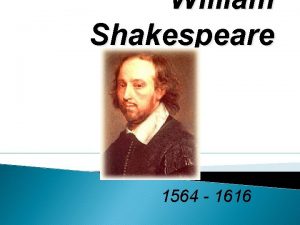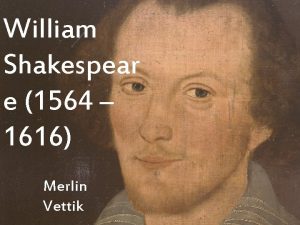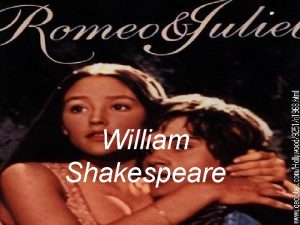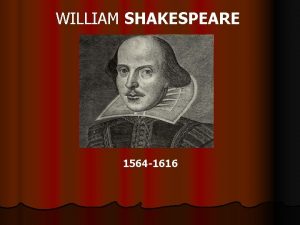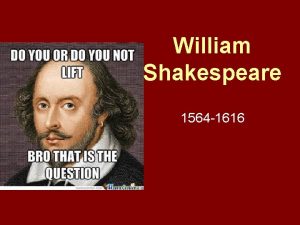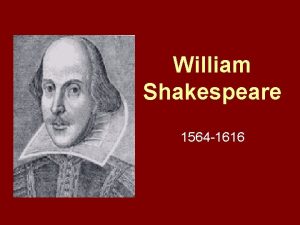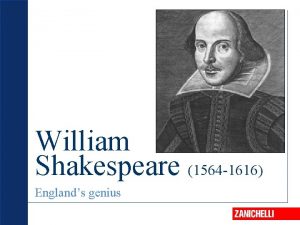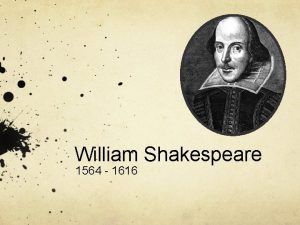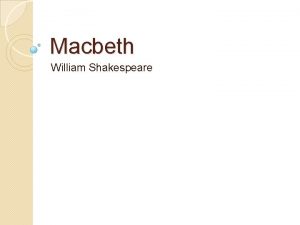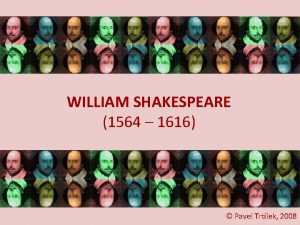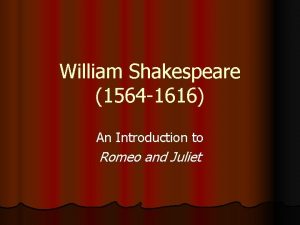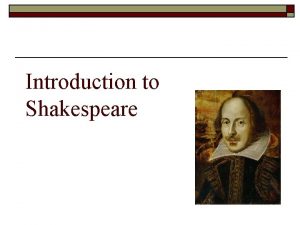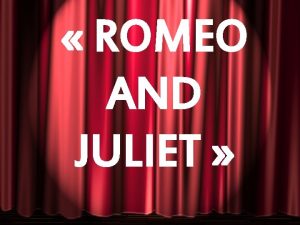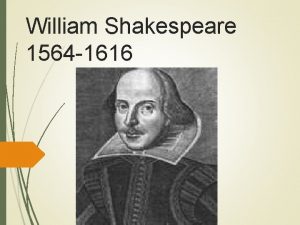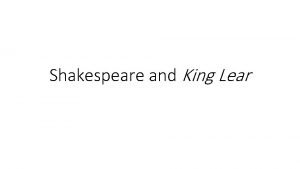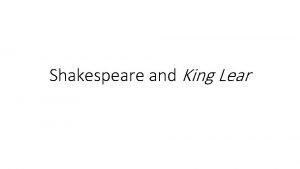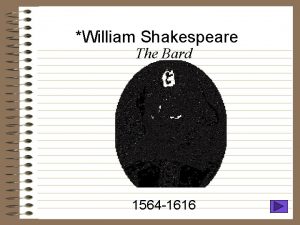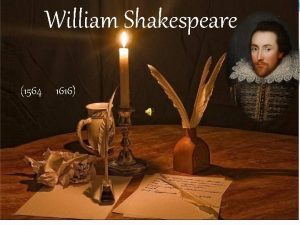William Shakespeare 1564 1616 An Introduction to Romeo
























































- Slides: 56

William Shakespeare (1564 -1616) An Introduction to Romeo and Juliet

Shakespeare’s Childhood Born on April 23, 1564 in the town of Stratfordon-Avon in England l His family was middle-class (father later became mayor of the town, mother’s ancestors had some social rank) l l l Ironically both his parents were illiterate (but this was also very common for the day) He enjoyed a typical, but unremarkable education at the Stratford Grammar School, which focused on a classical education in history, reading, and Latin.

More about his background… l At age eighteen, he married Anne Hathaway who was twenty-six (eight years his senior—how scandalous!) l They had three children together Ten years later, in 1592, he left his family for London and begun his writing career l By 1594, he was writing and performing with a group of actors known as “Lord Chamberlain’s Men” l l Very popular group, often performed for royalty and most London theatre-goers (remember this is before movies, so he was sort of famous guy)

“The Bard” is born! l He wrote Romeo and Juliet in 1594 l Shakespeare’s version was based on another playwright’s work, entitled The Tragicall Historye of Romeus and Juliet (1562) l Interesting historical note: Since there were no copy-right laws at the time, writers were extremely competitive at the time (and it was common practice among writers to “borrow” ideas– with or without the author’s permission)

Biographical Timeline l l l 1594 – Shakespeare becomes a shareholder in Lord Chamberlain’s Men 1599 - Lord Chamberlain’s Co. built the Globe Theater (where most of Shakespeare’s plays were performed) 1603 – James I becomes the King of England (after Queen Elizabeth dies)– Renamed acting company “King’s Men” 1610 – Shakespeare retired to Stratford-on-Avon 1616 – The famous playwright dies at age 52

Why is he still so famous? l His plays feature universally identifiable characters and situations l Such as love, marriage, death, grief, making difficult choices, separation, reunion and reconciliation l These characters are fresh and can be adapted to any time and place and help us (the audience) understand what it is to be human and cope with the problems that plague the human spirit

Enduring Language l Shakespeare’s characters used wonderfully colorful words and expressions l He used over 20, 000 words in his works l l The average writer uses only 7, 500– whoa! Interesting fact– the English Dictionary of his time only had 500 words l Shakespeare is responsible for adding 3, 000 words to the English Oxford Dictionary He had an enormous influence on the development of modern English l He’s credited with inventing some of the words we still use in our daily speech l

Such as… l l l Accommodation Amazement Assassination Bloody Countless Critic Exposure Generous Gloomy Hurry Impartial l l Lonely Majestic Misplaced Obscene Premeditated Radiance Reliance Road Submerge Suspicious l … among many others!

Shakespeare wrote: l. Comedies l. Histories l. Tragedies

The Theater in Shakespeare’s Day l Plays produced for the general public l Took place in an roofless / open air theatre (Thank goodness because public sanitation, hygiene and common decency were not as we expect them to be today!) l Building had three levels l Stage: l A large platform without a curtain

Shakespeare’s Globe Theater

Elements of a Drama l These are the FIVE (5) parts that correspond to the five ACTS of plays l Exposition (the introduction) l Establishes the TONE, introduces the setting, the main characters, and the conflict l It may also provide additional background info important to understanding the plot l In Romeo & Juliet, there was a Prologue to provide a comprehensive summary of the plot l Rising Action l Series of complications for the protagonist (main character) l Flows from the main character

Elements of a Drama (continued) l Climax (or crisis) Turning point in the story l The moment of choice (an important decision must be made) l Forces of conflict come together l l Falling Action Results of protagonist’s decision l Maintains suspense l l Resolution Conclusion of the play l Unraveling of the plot l Typically, in a Shakespearean play, may include the characters’ death l

Dramatic Techniques l Pun l A play on words involving A word or words with more than one meaning, or l Words with similar sounds l l Soliloquy Medium to long speech l Spoken by one actor alone on stage (or not heard by other actors) l l Monologue One person speaking for a longer period of time l Is NOT a dialogue (which is an fair exchange of words between two or more characters) l

Some additional dramatic techniques l Comic Relief l Use of comedy or humor used to provide “relief” from the seriousness or sadness, or to “relieve” the tension of the situation l Aside l Direct address by actor to audience l Not supposed to be overheard by other characters

More Dramatic Techniques: Poetic Language l Metaphoric Language l Comparison of unlike things l “Shall I compare thee to a summer’s day? . . . ” l Alliteration l A repetition of a consonant sound at the beginning of a word l Ex. “She sells sea shells by the sea shore. ”

Dramatic Themes l Theme l Central idea or insight about life featured in the plot l Tragedy (Shakespearean) l Drama where the central character/s suffer disaster or great misfortune l In many tragedies, this downfall results from l FATE l CHARACTER FLAW / FATAL FLAW l Or a combination of these two

Types of Characters l Static (or “Flat” characters) l l Dynamic (or “Round” characters) l l Characters within a story who remain the same– they DO NOT change their minds, opinions, or character Possess many character traits, like “real” people Dramatic Foil l A character whose whole purpose is to show off another character l Look for how Benvolio does this for Tybalt’s character in the story

Poetic Techniques l Blank Verse l Unrhymed iambic pentameter l Iambic Pentameter l 5 units of rhythm per line l A meter consists of five (5) pairs in a two (2) syllable stressed/unstressed pattern l Follows pattern of unstressed syllable followed by a stressed syllable l Primary rhythm is iambic– l Unstressed/ Stressed /Unstressed

Understanding Shakespeare’s Meter l Foot/Feet: In Shakespeare’s poetry, it is the smallest unit of rhythm (more commonly referred to as a “Meter”) l Meter is a measure of the time-pattern that is repeated l l Iamb: l l A foot of two-syllables with unstressed syllable followed by the stressed syllable Iambic Pentameter 5 foot metrical line of weak followed by strong syllables l Each line is 10 syllables long in Shakespeare’s sonnets l l Intended for actors to speak lines naturally when performing a play

An Example of Shakespeare’s Iambic Pentameter But, | soft! |what | light | through | yon|der | win|dow | breaks? (iambic pentameter = 10 syllables per line, or meter of text) Act 2, Scene 2 Romeo & Juliet

Poetic Techniques l English Sonnet l Fourteen line poem (Shakespeare of them!) wrote 154 l Each line contains ten syllables and written in iambic pentameter l Rhyme scheme in a Shakespearean sonnet is a-b-a-b, c-d-c-d, e-f-e-f, g-g* l *The last two lines are a rhyming couplet

Figurative Language: Oxymorons l An oxymoron is a term that sounds logical (in the figurative sense), but contain words that with illogical literal meanings like ‘plastic silverware. ’ These terms have a contradictory meaning and serve to have a specific effect on the audience. List 3 on your own right now: l 1. ________ l 2. ________ l 3. ________ l

Beginning Romeo & Juliet l Based on the meaning of the stems, what can you infer the purpose is of a prologue. l pro=? l logue?

An Example of a Sonnet (from the prologue of Romeo & Juliet) Chorus 1 Two households, both alike in dignity, 2 In fair Verona, where we lay our scene, 3 From ancient grudge break to new mutiny, 4 Where civil blood makes civil hands unclean. 5 From forth the fatal loins of these two foes 6 A pair of star-cross'd lovers take their life; 7 Whose misadventured piteous overthrows 8 Do with their death bury their parents' strife. 9 The fearful passage of their death-mark'd love, 10 And the continuance of their parents' rage, 11 Which, but their children's end, nought could remove, 12 Is now the two hours' traffic of our stage; 13 The which if you with patient ears attend, 14 What here shall miss, our toil shall strive to mend. [Exit. ]

Relating to the Text l What sort of actions preclude a fight? l AND… l Do you ever HAVE to fight? l When is it acceptable to walk away?

1 st period Learning Groups Amina l Erica l Anthony l Jazmyn l Estefani l Abby l Destiny l Mosies l Crystal l Harper l Elainna l Christopher Jennifer l Isreael l Alex l Mouhcine l Nooha l Jonathan l l l Ivan l Roberto l Pooja l Jocelin l David l Krupa

3 rd period Learning Groups l Ashra l Andrea l Anthony l Jonathan l Racquel l Emmanuel l l Aman l Jesus l Mayra l Jeffery l Matthew l Braijon Vanessa l Almedina l Isiah G. Jacob l Brian l Harold l Lee

4 th period Learning Groups Sulema l Angelo l Jahquann l Andre l Nathan V. l Ana l Litze l Yan l Jasmin T. l l Lupe l Erick l Nataly l Andy l Alexis l Zoe l Jennifer l Caleb l Modesty l Bruk l Louis l l Carla l Ashley l Abdullah l Melissa l Mirian l Jasmine N. Alyssa l Virgil l Nathan T.

8 th period Learning Groups Ivan l Christian l Robert l Andrew l Arnold l Yocelin l Jasmine H. l Celeste l Emily l l Edward l Claudia l Amy l Malorie l Bernardo l Arreana l Bryan l Lily l Juliajoy l Johnnasy l Jake l Jazmine l l Jalen l Jose l Tanner Lorenzo l Michael l Melissa

Learning Group Activities Step 1: Determining Roles l 1 Facilitator l Responsible for keeping the group on task and focused, ensures that all group members have had an opportunity to participate and that the group has met the goals of each activity in an assignment l 1 Recorder/Reporter l Keeps the records for the group, takes notes, keeps all handouts, etc. and functions as the spokesperson for the group l 1 -2 Research Guru(s)/ Literary Luminary (ies) l Responsible for ensuring that all responses to the text are supported with clear evidence from the text AND that the group’s responses are enhanced with additional research (i. e. looks up unfamiliar words, concepts, etc.

Step 2: Identifying Themes l Take turns sharing what each member annotated from Act I, Scene 1 in Romeo & Juliet (pgs. 7 -25). Identifying l qualities or traits of major characters by his or her quotations l Major and minor conflicts l Major themes in R & J l Reason / Impulse l Loyalty / Independence l Pride / Humility l Hope / Despair l Fate / Free-Will

Step 2. 5: Sharing Your VIPs (Very Important Points) l VIPs=Very Important Points l These are the annotations that your group has determined to be the most insightful l Each group will share with the class your THREE (3) VIPs best examples of your annotations l Make sure you cite the page and line #’s from the text, summarize or quote the text and fully explain your interpretation of its meaning

For Example Text Me Page 7 in the Prologue lines 3 -4 “from ancient grudge break to new mutiny” The term mutiny refers to a riot, which means that the conflict between the Capulets and Montagues impacts everyone in the community and that impulsiveness overrules reason in Verona. I wonder if the Prince has personal, political motivations to solve the conflict

Step 3: Take Turns Sharing Your Experience with the “Perfect Mate” Activity (be prepared to share with the class) l Compare and contrast your experiences with Romeo’s l Based on what you’ve read so far, what does Romeo want in a relationship? l Is this more like or unlike what the members of your group is looking for in a commitment? l Now compare and contrast your experiences with those of Juliet and her parents. l How were your interactions similar? l How were they different?

Making Meaning of the Text Act I, Scene 2, Lines 1 -12 Capulet But Montague is bound as well as I, In penalty alike, and ‘tis not hard, I think, For men so old as we to keep the peace. Paris Of honorable reckoning are you both, And pity ‘tis you lived at odds so long. But now, my lord, what say you to my suit? Capulet But saying o’er what I have said before. My child is yet a stranger in the world. She hath not seen the change of fourteen years. Let two more summers wither in their pride Ere we may think her ripe to be a bride. Interpretation– What is said? Capulet Montague is subject to the same penalty (of death), and it shouldn’t be so unreasonable for mature men to keep the peace. Paris Both of you are honorable men and it’s sad that you’ve fought for so long, but more importantly, what do you think about my proposal? Capulet I’ve said this before, my child doesn’t have much life experience She’s not even fourteen. Let’s let two more summers pass before we decide she’s old enough to get married.

What does it matter? Text Analysis l l l In Act I, Scene 2, Lines 1 -13 we meet Lord Capulet (Juliet’s father) who has been approached by Count Paris for Juliet’s hand in marriage. When the scene opens, Capulet is reasoning that Montague and should be mature enough to know how to be civil and avoid the Prince’s harsh penalty. Paris agrees, but is more concerned about whether Capulet will accept his proposal for Juliet’s hand in marriage Consider why Count Paris would want to marry Juliet– what does he stand to gain as a result? l Consider why Capulet would want to postpone his daughter’s marriage (hint: there’s probably more than one correct answer here) l

Learning Group Activity: Jig-Saw Text Interpretation l Each learning group will be responsible for reading and interpreting 10 lines of the text for the class. l In your groups l Take 5 minutes to read and deconstruct the lines with your group l On your own l Be sure to write down each group’s interpretations as part your own INDIVIDUAL ANNOTATIONS (that’s what makes the jig-saw interpretation so successful– when everyone helps out, challenging texts are easy to understand!)

SAYS-MEANS-MATTERS As a learning group l Determine who will read the true text (SAYS), l who will share your group’s interpretation, (MEANS), and l who will share your group’s analysis of the significance with the class (MATTERS).

The Structure of a Shakespearean Tragedy Act III: Rising Action Climax Act II: Rising Action (with exciting force) Act I: Exposition, Conflict, Rising Action Act IV: Falling Action Act V: Falling Action, Catastrophe

Act I: The Exposition l Introduction to the plot of the play l Setting l Characters l Major l Some minor l Conflict l Complication l THEME

On a sheet of paper, answer A & B: (this will NOT be shared with any of your peers in this class if you choose) ACT II: The Complication Bell-Ringer l Think about What is appealing about someone them? (Cite as many l you have adjectives as possible) dated, B. What did you say- or do l are currently - (or would say or do) to dating or persuade them to get to l would like to know you better? date… A.

Act II: A Balancing Act BELL-RINGER Have you heard the saying, “opposites attract”? Answer the following on a sheet of paper. 1. What does it mean (provide an example if you can)? If you’re unfamiliar with this idea, what do you Define in your own words Do you agree with this concept? Why or why not? Explain think it means? 2. Finally, cite as many examples of opposites as you can in Romeo & Juliet. l Bonus: What is an example of oxymoron? 3.

Exit Reflection l Is it possible that there is good and evil within everyone? Explain how this seeming imbalance provides balance. Please write this response at the bottom of your bell-ringer.

05/22/14 Bell-Ringer: SAYS-MEANS-MATTERS Read the last FIVE (5) lines of Act II, Scene 3: Friar Laurence: In one respect I’ll thy assistant be; For this alliance may so happy prove To turn your households’ rancor to pure love. Romeo: Oh, let us hence! I stand on sudden haste. Friar Laurence: Wisely and slow. They stumble that run fast. SAYS-MEANS-MATTERS Interpret what these lines mean 2. ANAYZE the implications of why this passage matters 1. Be prepared to share!

SAYS-MEANS-MATTERS l Review Friar Laurence’s soliloquy that opens Act II, Scene 3 Lines 1 -30 l Choose any couplet (two lines) WRITE what they SAY 2. INTERPRET what they MEAN 3. ANALYZE why these lines matter to understanding themes (of which opposition is one) of the play 1.

You’re cordially invited…. . Activity Guidelines Presentation Grading Rubric …to create the wedding 20 Points awarded to each member of the group if all of Romeo and Juliet! participants l In your Learning Groups, l stay in character, determine who will play the role of Romeo, Juliet, Friar l demonstrate professionalism, l show creativity, yet remaining Laurence (and if needed, faithful to the plot of R&J the Nurse) l are respectful and attentive l What would they say to during the presentations all one another to pledge their groups undying love to one another? l EXTRA CREDIT: USES OLD ENGLISH l For this activity, you may use modern English


Themes Major Overarching Themes Passion l l (violence vs. love) Opposition/Opposing Forces these are only a few examples of this theme: Montague vs. Capulet l Light vs. Dark l Day vs. Night l Comedy vs. Tragedy l Additional Themes Fate vs. Free-Will l Reason vs. Impulse l Pride vs. Humility l

Annotating the Text for a Purpose l Annotations should be made for a purpose. In other words, why annotate? l Therefore, your annotations will be focused on identifying and selecting the best examples of the major themes appearing in Shakespeare’s Romeo & Juliet

Exit Reflection l Review the action of Act III, scene 1 l What was the most important part of that scene? (Summarize and explain) l Cite line numbers to strengthen your claim l Identify which of the major themes is illustrated by the lines you selected. l BRIEFLY EXPLAIN WHY THIS IS

Identifying Your VIPs (Very Important Points) l l Review the action in each of the three acts we’ve studied of the play What were the THREE (3) most important annotations you needed to make for EACH of the Acts? With the members of your group, share your annotations, determine which THREE were the most relevant to understanding the plot and the author’s motivations Be prepared to share your three VIPs with the room

SAYS – MEANS - MATTERS l For each of your VIPs, follow the says-meansmatters strategy l Says: Document the lines your group selected (either summarize the scene or provide a direct quote– regardless, you must CITE the text) l Means: Interpret the text; what does it say? l Matters: Analyze the significance of the text – why does this portion of the text matter to understand the plot and author’s motives?

Tableau: Instragram Like frozen statues, arrange yourself to show the “snapshot” within the scene your group has determined is the most important. l This activity is demonstrated for Romeo and Juliet, Act 3, scene 1.

Answer on the back CERA Please provide a claim-evidence paragraph answering the following prompt: 7. Based on this reading, what could you infer were the motivating factors influencing Shakespeare’s writing of Romeo & Juliet? l In other words, what do you suppose was the author’s purpose for writing? Based on your understanding of the reading, do you suppose he was successful in this endeavor? Explain why or why not supporting your claim with evidence from the text.

Summarizing the Action in ACT III (The Climax) Directions: Summarize each of the FIVE (5) scenes in this act in a concise sentence Aim for 5 -10 words, not counting prepositions and/or articles l Think of writing it like a headline or a Twitter post l ACT III Scene 1: Plot turns from comedy to tragedy with the violent deaths of Mercutio (accidental--fate), and Tybalt (murder– free-will) l Scene 2: ___________________________ l Scene 3: ___________________________ l Scene 4: ___________________________ l Scene 5: ___________ l
 William shakespeare 1564 to 1616
William shakespeare 1564 to 1616 William shakespeare 1564 to 1616
William shakespeare 1564 to 1616 William shakespeare retirement
William shakespeare retirement William shakespeare 1564 1616
William shakespeare 1564 1616 1564-1616
1564-1616 1564 1616
1564 1616 William shakespeare timeline
William shakespeare timeline 1564 to 1616 england timeline
1564 to 1616 england timeline British renaissance timeline
British renaissance timeline William shakespeare born
William shakespeare born William shakespare wife
William shakespare wife Poem for romeo and juliet
Poem for romeo and juliet The tragedy of romeo and juliet by william shakespeare
The tragedy of romeo and juliet by william shakespeare Romeo and juliet by william shakespeare summary
Romeo and juliet by william shakespeare summary Shakespeare wrote romeo and juliet
Shakespeare wrote romeo and juliet Facts on romeo and juliet
Facts on romeo and juliet Dramatis personae romeo and juliet
Dramatis personae romeo and juliet Hamlet introduction
Hamlet introduction Who wrote macbeth
Who wrote macbeth Tybalt act 1
Tybalt act 1 Romeo and juliet script oh romeo i've missed you
Romeo and juliet script oh romeo i've missed you Hold thy desperate hand
Hold thy desperate hand Date romeo and juliet was written
Date romeo and juliet was written Where art thou romeo meaning
Where art thou romeo meaning That dreamers often lie literary device
That dreamers often lie literary device Happiness courts thee in her best array
Happiness courts thee in her best array April 23 1616
April 23 1616 April 23 1616
April 23 1616 Totus mundus agit histrionem
Totus mundus agit histrionem 16 cfr 1616
16 cfr 1616 Saavedra cervantes
Saavedra cervantes William shakespeare was born in stratford upon avon
William shakespeare was born in stratford upon avon Julius caesar webquest
Julius caesar webquest Why is william shakespeare called the bard
Why is william shakespeare called the bard Who was shakespeare
Who was shakespeare William shakespeare pictures
William shakespeare pictures Anja pintar
Anja pintar Fun facts about william shakespeare
Fun facts about william shakespeare гушак
гушак William shakespeare childhood
William shakespeare childhood William shakespeare english poets
William shakespeare english poets When was shakespeare born
When was shakespeare born Shakespeare biography english
Shakespeare biography english Neither a borrower nor a lender be quote
Neither a borrower nor a lender be quote William shakespeare aka
William shakespeare aka Shakespeare date of birth
Shakespeare date of birth Julius caesar family tree
Julius caesar family tree William shakespeare lived
William shakespeare lived The life and times of william shakespeare
The life and times of william shakespeare Was william shakespeare in the renaissance
Was william shakespeare in the renaissance Sonnet 60 by shakespeare
Sonnet 60 by shakespeare William shakespeare sonnet 43
William shakespeare sonnet 43 Shakespeare 1587
Shakespeare 1587 Shakespeare sonnets 1
Shakespeare sonnets 1 William shakespeare sonnet 130 summary
William shakespeare sonnet 130 summary William shakespeare renässansen
William shakespeare renässansen Othello story summary
Othello story summary


